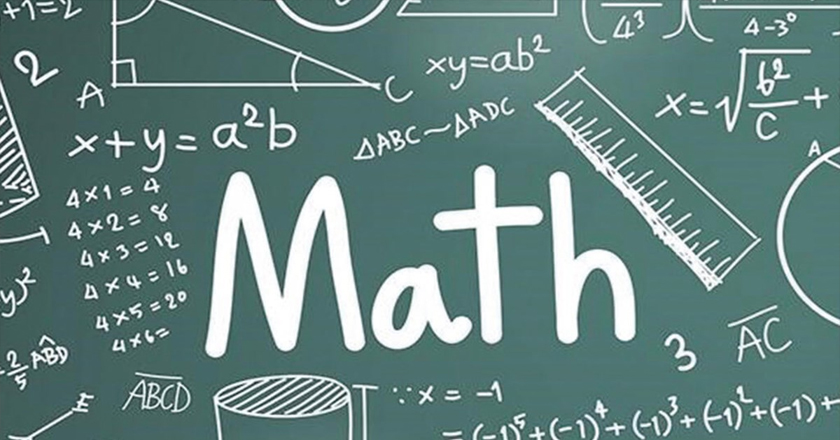Maths
- Description
- Curriculum

Pre-Algebra
Here the independent variable is ‘x’ and the dependent variable is ‘y’. ’a‘ is the constant term or the ‘y’ intercept. It is the value of the dependent variable when x = 0. ’b‘ is the coefficient of the independent variable. It is also known as the slope and gives the rate of change of the dependent variable.
13 gallons (a measure of volume) into an automobile. To pay for the gas, the motorist uses dollars—another unit of measure, economic rather than scientific—in the form of paper money, a debit card, or a credit card.
If one of the angles of a triangle measures 90 degree, we call it a right angled triangle, or a right triangle. Sides of such a triangle satisfy the Pythagorean theorem: a^2+b^2=c^2, where the largest side is ‘c’ and is called the hypotenuse. ‘a’ and ‘b’ represent the lengths of the other two sides.
We can find many relationships between two or more angles, if certain conditions are met. Examples include complementary angles, supplementary angles, congruent angles etc.
Transformation refers to the movement of objects in the coordinate plane. In case there is change in the shape/ size, we refer to the original shape as the object and the transformed shape as the image. There are various ways to transform an object. Different types of transformation are translation, rotation, reflection, and dilation. You can relate to translation when you think of pushing a box from one side of the room to another. An example of a rotation in real life is Earth’s rotation around its axis. When you look into the mirror, you see your own reflection. When an eye doctor dilates your eye it enlarges the pupil, letting the eye doctor examine it closely. All these can be connected to the transformations in Math.
Polynomials are expressions that have constants, variables & exponents, which are combined using addition, subtraction, & multiplication. Each piece of the polynomial, or each part that is being added, is called a “term”.
Eg: (1) X^2 + 5X = 7
(2) 3X+1=0.
The exponents in a polynomial can only be positive, whole numbers. We cannot have fractional powers and variables as denominators in a polynomial. Hence ‘x’ to the power of -5, ‘x’ to the power of 1/3, and 7 over ‘x’ to the power of 2 are not polynomials.
Algebra-1
Solving inequalities is similar to solving equations. In both, we do most of the same things, but in the case of inequality we should pay special attention to the “direction” of inequality too.
A function defines certain relationships and tries to give it a mathematical form. The relationship is between terms or objects in one set with those in another. If for each term in the first set- the domain – there is one and only one corresponding term in the other set- range, we call that relation, a function. We can graph functions exactly like how we graph equations. It gives a pictorial representation of the function.
A system of linear equations comprises two or more linear equations. The solution of a linear system is the ordered pair that is a solution to all equations in the system.
One way of solving a linear system is by graphing. The solution to the system will then be the point at which the two equations intersect. We can solve linear equations by elimination method, cross multiplication method, and by substitution method too.
“Roots” (or “radicals”) are the “opposite” operation of applying exponents; you can “undo” a power with a radical. If you square 2, you get 4, and if you “take the square root of 4”, you get 2; if you square 3, you get 9, and if you “take the square root of 9”, you get 3. The radical expression has a radicand inside the root, and the power will be shown outside the radical sign.
A rational expression is nothing more than a fraction in which the numerator and/or the denominator are polynomials. So, we can call it as “Polynomial Fraction”!
A system of equations is a collection of two or more equations with the same set of unknowns or variables. In solving a system of equations, we try to find values for each of the unknowns that will satisfy every equation in the system. The equations in the system can be linear or non-linear.
A polynomial equation in a single variable, where the highest power of the variable is 2, is called a quadratic equation. There will be two “roots” or “solutions” for a quadratic equation. The solutions of the quadratic equation ax^2 + bx + c = 0 correspond to the roots of the function f(x) = ax^2 + bx + c, since they are the values of ‘x’ for which f(x) = 0. The name Quadratic comes from “quad” meaning square because the variable gets squared (like x2). It is also called an “Equation of Degree 2”. We can solve a quadratic equation using any of the three methods: (1) Factoring (2) Completing the square (3) Using the quadratic formula.
An exponent tells us how many times a particular number is multiplied by itself. We can consider function as a relation between two sets of numbers where, in the first set all the numbers are unique or different, and every number in the first set has at least one corresponding number in the second. There are functions where the base is a variable and exponent is a number. Eg: f(x) = x^2. However, exponential functions are functions where the base is a number and the power is an exponent. Eg: f(x) = 2^x
Matrix is a rectangular array of numbers. Matrices are widely used in solving problems in areas like Electronics, Robotics, Genetics, Linear Programming etc. The size of a matrix is defined by the number of rows and columns that it contains. A matrix with ‘m’ rows and ‘n’ columns are called an m × n matrix or m-by-n matrix, while ‘m’ and ‘n’ are called its dimensions.
Determinant is a useful value that can be computed from the elements of a square matrix. The determinant of a matrix A is denoted det(A), det A, or |A|. The determinant tells us things about the matrix that are useful in systems of linear equations and helps us to find the inverse of a matrix, which is useful in calculus and more.
A set is a collection of objects which follow a common rule. The objects of the set are called elements. Eg: The set of even numbers, the set of movies I watched in the previous year, the set of girls in the class etc.
This is a technique widely used in “optimization”. It is the optimization of an outcome based on some constraints. It is trying to answer “What is the best?” and is very helpful in the decision making situations. The process could be maximizing or minimizing a function, based on a set of constraints, which could be equalities or inequalities. The general process for solving linear programming exercises is to graph the inequalities (called the “constraints”) to form a walled-off area on the x,y-plane (called the “feasibility region”).
Algebra-2
A sequence, or a progression, is an ordered list of numbers. Each of the numbers is called a term or an element of the sequence. The sum of the terms of a sequence is called a series. While some sequences are simply random values, other sequences have a definite pattern that is used to arrive at the sequence’s terms. Two such sequences are the arithmetic and geometric sequences. If a sequence of values follows a pattern of adding a fixed amount from one term to the next, it is referred to as an arithmetic sequence. If the pattern is that of multiplying with a fixed number, it is a geometric sequence.
If ‘b’is any number such that b>0 and b≠1, and x>0, then y=logb(x) is called the logarithmic function. The function is read “log base b of x” [or, logarithm of x to base b]. In this definition logb(x) is called the logarithmic form and b^y = x is called the exponential form.
Periodic function is a function that repeats its values in regular intervals or periods. In other words, a function f(x) is said to be periodic with period p if f(x)=f(x+np)
for n=1, 2, 3,……It has a graph that repeats itself identically over and over as it is followed from left to right. The most important examples are the trigonometric functions, which repeat over intervals of 2π radians.
Identity is an equation that is always true. Trigonometric identities are equalities that involve trigonometric functions and are true for every single value of the occurring variables. Geometrically, these are identities involving certain functions of one or more angles. They are distinct from triangle identities, which are identities involving both angles and side lengths of a triangle.
We get a conic section, when a plane intersects a cone. By changing the angle and location of intersection, we can produce a circle, ellipse, parabola or hyperbola. In the special case when the plain touches the vertex, it will be a point, line, or two intersecting lines.
What makes it complex is that it is the combination of a real and an imaginary number. A complex number is a number that can be expressed in the form a + bi, where ‘a’ and ‘b’ are real numbers and’ i’ is the imaginary unit, and it is the square root of −1. In this expression, ‘a’ is the real part and ‘b’ is the imaginary part of the complex number. Remember, imaginary numbers when squared will give a negative result.
Statistics is concerned with the collection, analysis, interpretation, presentation, and organization of data. In other words, it is the science of analyzing data and of measuring, controlling and reporting uncertainties. The practice of statistics utilizes data from some population in order to describe it meaningfully, to draw conclusions from it, and make informed decisions. It finds a wide range of applications across different areas like Economics, Education, Engineering, Astronomy, Genetics, Biology, Psychology, Marketing, sports, and many others.
Geometry
A circle is the locus of all points equidistant from a central point. We can call it as a line, in the form of a closed loop where each point on it is at a fixed distance from a centre point.
Quadrilateral means “four sides” (quad means four, lateral means side). In Math, a quadrilateral is a polygon having four sides and four angles. Some of the common quadrilaterals are rectangle, square, parallelogram, rhombus etc.
Lines that are in the same plane, the same distance apart, and never touch are said to be parallel lines. No matter how far you extend them they never meet. If two lines in the same plane intersect each other at 90 degree, we say they are perpendicular to each other.
Two triangles are congruent or identical if they are of the same shape and size. In other words, if two triangles are congruent, their corresponding sides and corresponding angles will be equal.
Two triangles are similar if they have the same shape, but different size. If two triangles are similar, their corresponding angles will be equal and corresponding sides proportional.
The science of reasoning and proof is helpful around a wide range of situations in daily life. In the context of Math it deals with formal justification and reasoning for various concepts, theorems etc. A proof is nothing but a deductive argument.
Geometry deals with shapes and measurements. If plane geometry is for two dimensional shapes or objects, solid geometry is for the three dimensional. In coordinate geometry position of points on the plane is described using an ordered pair of numbers, which form the coordinates. There is wide application of this branch of Math in designs, architecture, space research, and many more areas.
Pre-Calculus
Vectors are used to represent quantities that have both a magnitude and a direction. Force and velocity are examples of vectors. In a graphical sense the vectors are represented by lines; the length of the line shows the magnitude, and its direction shows the direction of the vector. We can also say that a vector describes a movement from one point to another.
Parametric equations take an equation in two or more variables and define each variable in terms of one variable called the parameter. The parametric equations for a line are derived from its vector equations.
In Math we very often come across two important aspects -discovery and proof. Mathematical induction is a method of mathematical proof typically used to establish a given statement for all natural numbers. Generally the induction proof of a formula has three steps: (1) Shows that the formula is true for n+1 (2) Assumes that it is true for n (3) Proves that it is true for n+1
Permutation: Permutation means arrangement of things. The word arrangement is used, if the ‘order’ of things is considered. Permutation tells us the number of ways in which you can arrange items, when the order is important.
Combination: Combination refers to selection of things. The word selection is used, when the order of things has no importance. It tells you in how many ways you could choose a group from a larger group. Here the order does not matter.
Binomial theorem (or binomial expansion) describes the algebraic expansion of powers of a binomial. It helps in expanding binomial expressions with large powers, easily.
Limit is the value that a function or sequence “approaches” as the input or index approaches some value. The limit of a sequence helps us to find out the value of the sequence at an infinite point. Similarly the limit of a function at a particular value tells us a lot of information regarding the function, around that value.
One of the concepts at the core of Calculus. The derivative of a function represents an infinitesimal change in the function with respect to one of its variables. The geometrical approach views it as the slope of a curve at an exact point, while the physical approach says it is the rate of change.
The “simple” derivative of a function ‘f’ with respect to a variable ‘x’ is denoted either f^'(x) or (df)/(dx),
Integrals together with derivatives are the fundamental objects of calculus. An integral is a mathematical object that can be interpreted as an area or a generalization of area. There are definite and indefinite integrals.
Calculus
f(x) → L as x → a means that f(x) approaches the number ‘L’ as ‘x’ approaches (but is not equal to) ’a‘ from both sides. A more precise way of describing it is that we can make f(x) be as close to ‘L’ as we like by making ‘x’ be sufficiently close to ‘a’. A function can be either continuous or discontinuous. With knowledge around limits and continuity, you are ready for Calculus.
The “simple” derivative of a function ’f’ with respect to a variable ‘x’ is denoted either f^'(x) or (df)/(dx),
Derivatives denote the rate of change. When there are multiple variables, but if the derivative is arrived at considering only one of the variables at a time, it is “partial”! Hence partial derivative of a function of several variables is its derivative with respect to one of those variables, with the others held constant. Note that we use slightly different notations for ordinary and partial derivatives.
Any calculus based optimization situation involving more than one variable uses partial derivatives. Partial differential equations are used to mathematically approximate many physical phenomena like fluid flows, nerve conduction, force in a spring etc. Economists use it in analyzing the economic behaviour, which might include more than one variable.
Integrals and derivatives are the basic objects in calculus. Widely used by physicists and engineers, integral refers to the area of certain types of regions. There are definite and indefinite integrals. Integration can be used to find areas, volumes, central points, and many more.
With line integral, instead of integrating over intervals, here it is done over a curve. Surface integral is used in general to refer to multiple integrals to integration over surfaces.
An integral is improper if either the interval of integration is not finite or the function to integrate is not finite. Improper integral is the limit of a definite integral as the endpoint of the interval(s) of integration approaches either a specified real number or, in some cases, as both endpoints approach limits. In other words, integrals that have discontinuous intervals or where the interval of integration is not finite are called improper integrals.
It is the third ‘limit process’ in calculus, after differentiation and integration. Infinite series is a “sum” of the terms in a series. An infinite series is an expression like this: S = 1 + 1/2 + 1/4 + 1/8 + … The dots mean that infinitely many terms follow.
A Fourier series is an expansion of a periodic function f(x) in terms of an infinite sum of trigonometric functions. Fourier series make use of the orthogonality relationships of the sine and cosine functions. It has got wide range of application in applied mathematics, and especially in physics and electronics. The concept was introduced first by the French mathematician, Joseph Fourier.
An important tool in the theory of partial differential equations, used in mathematical analysis.
Gamma function is a generalization of the factorial function. It is possible to show that the limit of the Gamma function at 0 from the right is infinity. Beta function is also called the Euler integral of the first kind.
Let ‘f’ be a function of a complex variable, defined over a domain. If z=x+iy , where ‘x’ and ‘y’ are real numbers, then ‘z’ is written in algebraic form. We can write f(z)in algebraic form as f(z)=u(x,y)+i v(x,y). Here f(z) is the function of the complex variable ‘z’.
Cartesian coordinates are not the only way to define a point in a two dimensional space. The polar coordinates of a point describe its position in terms of a distance from a fixed point (the origin) and an angle measured from a fixed direction which, interestingly, is not “north” (or up on a page) but “east” (to the right). That is in the direction ‘Ox’ on Cartesian axes.
So, we choose a fixed point ‘O’, known as “the pole”.



